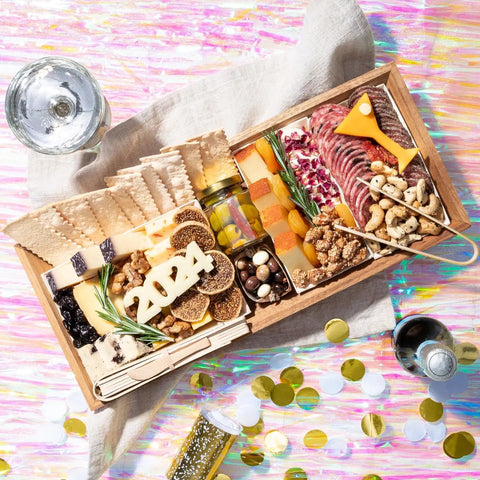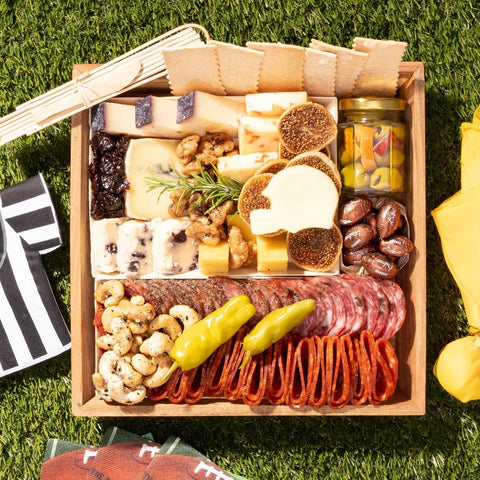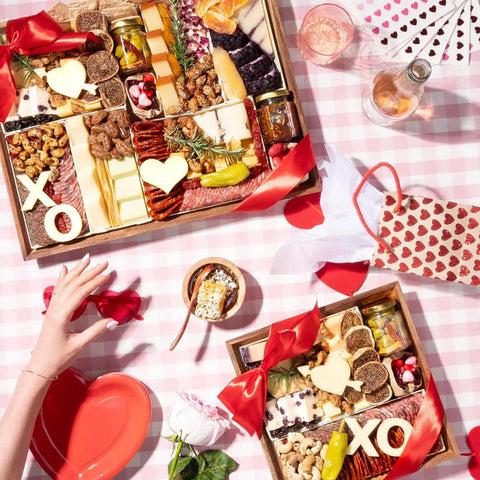Grazing boards are the pinnacle of easy entertaining, offering a relaxed yet sophisticated way of serving food that caters to everyone's taste. They transform the concept of snacking into an art form, where variety and abundance take center stage. Imagine a platter brimming with an assortment of cheeses, meats, fruits, and nuts, arranged not just for taste but for aesthetic appeal. It's a culinary canvas that invites creativity and communal dining, turning ordinary gatherings into memorable feasts. This concept is not just about food; it's about creating experiences, where every bite tells a story of texture, flavor, and harmony.

Starting with the Basics: Components of a Grazing Board
Choosing the Right Platter
The size of your board should match the number of guests you're expecting. A large grazing board is ideal for big gatherings, while a smaller board suits intimate affairs. Material-wise, wooden boards offer a rustic charm, marble provides a touch of elegance, and slate adds a modern edge. Consider the theme of your event when choosing, as the board itself sets the tone for the feast. It's not just a serving tool; it's part of the presentation.
Cheese Selection
Cheese is the heart of any cheese grazing board. The key to a successful selection lies in offering a variety of textures and flavors. Include soft cheeses like Brie or Camembert, firm cheeses such as Cheddar or Gouda, and bold blue cheese for depth. For an easy grazing board, stick to crowd-pleasers like mozzarella and Swiss. Experiment with local and artisanal cheeses for a unique touch. The aim is to provide a balanced taste experience that encourages guests to explore and enjoy.
Charcuterie Choices
Charcuterie adds savory complexity to your board, ranging from salty prosciutto to rich pâté. For a charcuterie grazing board, select a variety of cured meats that offer different textures and flavors. Think thin slices of salami, speck, and chorizo alongside terrines and ham. This diversity not only caters to different palates but also enhances the overall grazing experience. Pairing meats with certain cheeses can highlight the unique qualities of each, creating a symphony of flavors on your board.
Fruits and Nuts
Fresh grapes, slices of pear, and berries offer a refreshing contrast, while dried fruits like apricots and figs provide a chewy texture. Nuts, from almonds to walnuts, introduce a satisfying crunch. This combination ensures a basic grazing platter is well-rounded, offering a palate-cleansing break between the more decadent cheese and charcuterie. Additionally, these elements contribute vibrant colors and shapes, enhancing the visual appeal of your board.
Elevating Your Board: Gourmet Grazing Boards Inspirations
Luxurious Cheese and Specialty Meat Pairings
Opt for aged cheeses like a 24-month Parmigiano-Reggiano or a creamy, complex Gorgonzola Dolce, and pair them with high-end cured meats such as Iberico ham or duck salami. These refined choices elevate the flavor profile of your board and introduce guests to a new level of taste sophistication. Incorporating a few selections of rare or aged meats and cheeses can turn a simple cheese for grazing board into an exquisite culinary adventure, making your gathering an unforgettable experience.
Exotic Fruits and Artisanal Breads
To further sophisticate your grazing arrangement, include exotic fruits and artisanal breads. Fruits like dragon fruit, persimmons, or starfruit not only add an exotic flair but also introduce a variety of textures and flavors. Artisanal breads, such as a crusty sourdough or a fragrant fig and walnut loaf, offer a hearty base for cheeses and spreads. These elements bring an artistic touch to your board, making it as delightful to the eyes as it is to the palate.
Unique Condiments and Spreads
Adding unique condiments and spreads to your grazing platter not only introduces an element of sophistication but also transforms it into a canvas of flavors, ranging from the depths of savory richness to peaks of sweet delight. These gourmet touches invite your guests to embark on a taste journey, experimenting with combinations that surprise and delight the palate. Let’s dive into how each condiment and spread can play a pivotal role in elevating your board:
- Truffle Honey: This condiment is a blend of the earthy, unmistakable aroma of truffles with the natural sweetness of honey, creating a luxurious topping that's perfect for drizzling over hard cheeses. The contrast between the sweet honey and the robust flavors of aged cheeses like Parmigiano-Reggiano or Pecorino creates a flavor profile that is complex and deeply satisfying. Truffle honey is not just a condiment; it’s an experience, adding a touch of opulence to your grazing board.
- Fig and Olive Tapenade: Combining the sweetness of figs with the salty, briny flavor of olives, this tapenade offers a rich and savory contrast that can elevate creamy cheeses to new heights. The complex flavors work beautifully spread on crusty bread or as a complement to the smooth texture of goat cheese or brie, offering a medley of flavors that dance on the tongue. This tapenade brings a Mediterranean flair to your board, inviting a journey to the sunny coasts with every bite.
- Aged Balsamic Vinegar: A drizzle of aged balsamic vinegar can add a profound touch of acidity and sweetness to fresh fruits or cheeses, creating a beautiful balance of flavors. Its thick, syrupy consistency and deep, complex taste can enhance the natural sweetness of fruits like strawberries or peaches, or add an interesting depth to milder cheeses.
- Spicy Mango Chutney: With its vibrant blend of sweet mangoes and a kick of spice, spicy mango chutney brings a delightful contrast to soft, mild cheeses. The chutney's texture and flavor can also add an exotic twist to crackers or bread, making it a versatile addition to the board. This condiment is for those who love a bit of heat with their sweet, offering a tantalizing flavor combination that wakes up the taste buds.
- Herb-Infused Olive Oil: Ideal for dipping bread or drizzling over vegetables, herb-infused olive oil combines the rich, fruity base of olive oil with the aromatic flavors of herbs like rosemary, basil, or thyme. This simple yet elegant condiment enhances the natural flavors of your board’s components, bringing a fresh and vibrant dimension to each bite. It’s a testament to the beauty of simplicity in elevating the dining experience.
These unique condiments and spreads into your big grazing board not only add a gourmet touch but also cater to a wide array of tastes and preferences, ensuring that each guest discovers their perfect pairing. This approach transforms your board from a mere collection of snacks into a curated flavor exploration, making your gathering memorable and distinguished.

Catering to All: Inclusive Grazing Board Options
Vegetarian and Vegan-Friendly Selections
Crafting a vegetarian or vegan-friendly grazing board involves selecting plant-based cheeses, such as those made from nuts, and an assortment of hummus and other bean dips. Incorporate a variety of fresh and pickled vegetables, alongside fruits and nuts, to ensure a rich diversity of flavors and textures. Vegan charcuterie options, like marinated tempeh or mushroom-based delicacies, can add the savory elements typically provided by meat.
Allergy Awareness and Labeling Tips
When hosting a gathering with a diverse grazing board platter, it's crucial to be mindful of guests' allergies and dietary restrictions. The key to safely catering to everyone is clear communication. Label each item on your board, highlighting potential allergens such as nuts, gluten, or dairy. Consider using color-coded picks or flags to indicate which items are safe for common dietary restrictions. Providing ingredient lists for homemade items can also be a thoughtful touch. Additionally, arranging the board so that allergen-free options are separated from potential contaminants helps to minimize the risk of cross-contact. This careful attention to detail ensures all guests can enjoy your grazing board with peace of mind, knowing their dietary needs have been considered.
The Art of Arrangement: Designing Your Grazing Board
Creative Layouts
Begin by placing larger items first, such as blocks of cheese or bowls of dips, to establish focal points. Then, arrange meats in flowing, ribbon-like shapes or roll them up for visual interest. Scatter fruits and nuts in between, using them to fill gaps and add color. For a truly artistic touch, consider creating patterns or themes with your ingredients, such as a color gradient or a shape motif. This thoughtful arrangement not only makes your board visually appealing but also invites guests to explore and sample its variety.
Accessibility and Flow
When designing your grazing board, consider the flow of how guests will interact with it. Arrange the board so that items are easily reachable and that there's a logical progression, perhaps starting with lighter flavors and moving towards richer, more intense ones. Ensure that utensils, plates, and napkins are conveniently placed to facilitate easy grazing. The goal is to create an experience that is not only enjoyable in terms of taste but also in terms of ease and comfort during the event.
Decorative Elements
Incorporating decorative elements like edible flowers and herb garnishes can elevate the appearance of your grazing board to new heights. Edible flowers such as nasturtiums, violets, or marigolds introduce a splash of color and an element of surprise, while sprigs of rosemary, thyme, or dill add a fresh aroma and a touch of greenery. These details not only beautify your board but can also complement and enhance the flavors of the other components. A thoughtfully decorated grazing board becomes a centerpiece in itself, a talking point that adds to the ambiance of your gathering.
Practical Tips for Preparing and Serving Grazing Boards
Serving Sizes and Quantities
Determining the right amount of food for your grazing board can be challenging, but a good rule of thumb is to allocate about 2-3 ounces of cheese and meat per person. For fruits, vegetables, and other accompaniments, aim for a total of 1-2 ounces per person. This estimation ensures a generous offering without an overwhelming abundance, allowing guests to try a bit of everything. Remember, the beauty of a grazing board is its variety and the opportunity for guests to sample multiple flavors.
Cleanup and Storage Solutions
Efficient cleanup and storage after any event are essential steps to ensure the longevity and freshness of both leftovers and unused ingredients. Properly managing these aspects not only helps in reducing waste but also in maintaining the quality of the food, making it enjoyable for days to come. Here’s a detailed guide on how to effectively store different types of food items:
- Cheeses: To preserve the moisture and texture of cheeses, wrapping them in wax or cheese paper is crucial. Unlike plastic wrap, these materials allow the cheese to breathe, preventing it from becoming too dry or developing mold prematurely. This method ensures that the unique flavors and creamy textures of the cheeses are maintained, allowing you to enjoy the remnants of your cheese selection in the days following your event.
- Meats: Meats should be tightly wrapped and refrigerated immediately after the event to prevent spoilage and bacterial growth. Using plastic wrap or aluminum foil can help seal in the moisture, keeping the meats fresh. For cooked meats, ensure they are cooled down before wrapping to avoid condensation that can lead to sogginess. To preserve the meats' flavor and safety so they can be eaten later, this procedure is essential.
- Fruits and Vegetables: Storing fruits and vegetables in airtight containers is the best way to retain their freshness and prevent them from absorbing odors from other foods in the refrigerator. For fruits like berries, a paper towel can be placed at the bottom of the container to absorb excess moisture and prevent mold growth. By storing them this way, you may keep your fruits and veggies fresher for longer and utilize them for snacks or meals in the future.
- Composting: Adopting an eco-friendly approach by composting food scraps is not only beneficial for the environment but also for your garden. Composting turns kitchen waste into rich soil, which can be used to improve the health of your garden plants. Items like fruit and vegetable peels, coffee grounds, and eggshells can all be composted. This practice reduces the amount of waste sent to landfills and provides a natural fertilizer for your plants.
Implementing these storage and cleanup methods after an event can significantly impact the preservation of your food, ensuring that leftovers remain delicious and fresh for as long as possible. Moreover, by adopting practices like composting, you contribute to a sustainable cycle that benefits both your household and the environment.

As you look forward to your next gathering, let the idea of a grazing board inspire you to create memorable and enjoyable moments. Whether it's a sophisticated wine pairing board, a playful dessert board, or an interactive board that gets everyone involved, the possibilities are endless. Each board is a blank canvas for your creativity, an opportunity to showcase your culinary skills and your thoughtfulness as a host. So, gather your ingredients, unleash your imagination, and prepare to impress your guests with a dazzling array of flavors and colors. The perfect grazing board is not just about the food; it's about the stories shared and the memories made around it.

